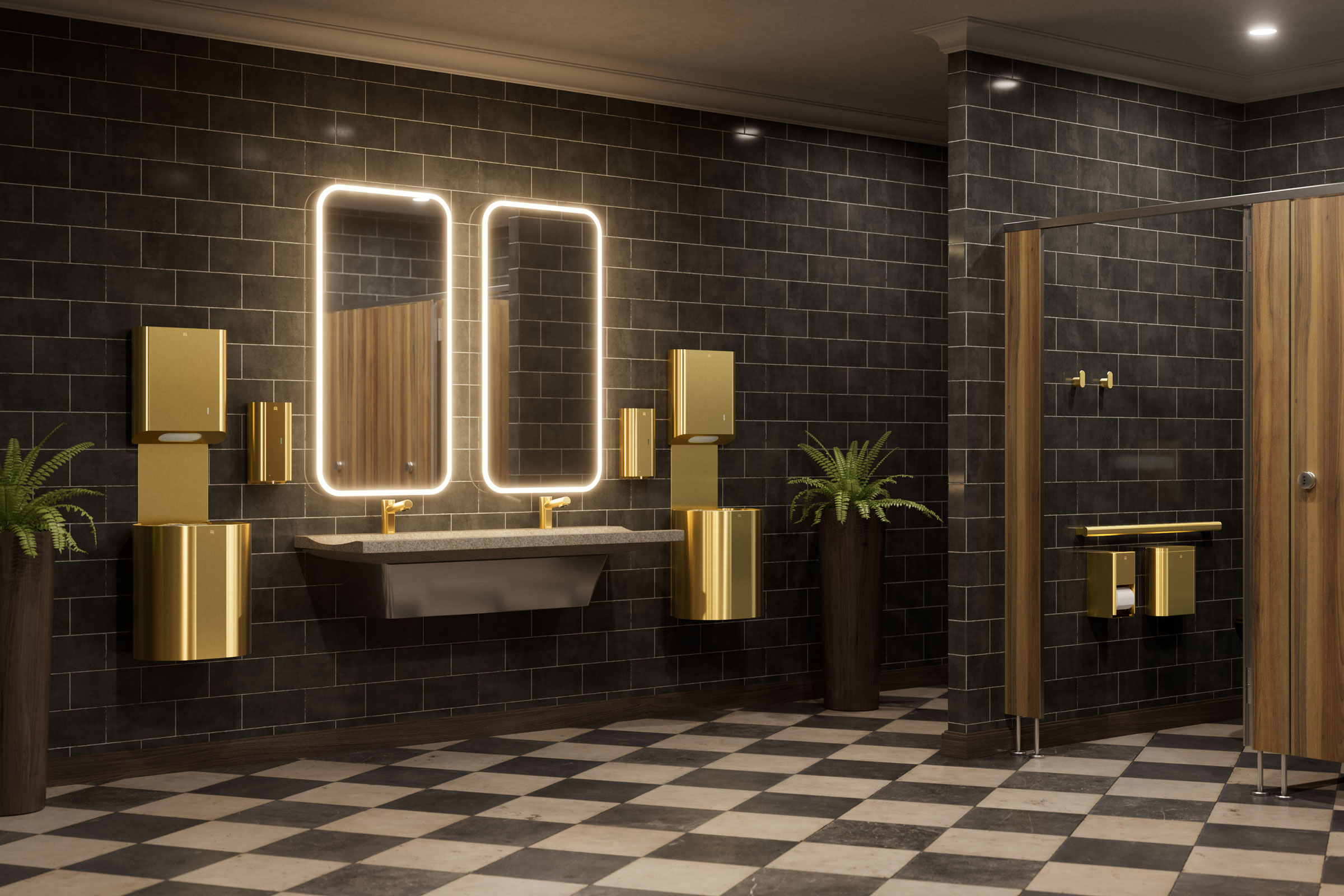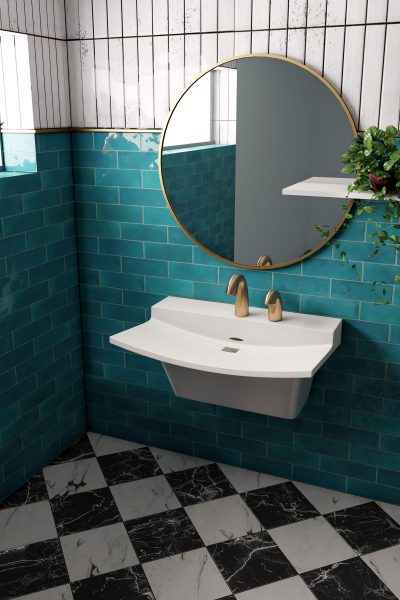Story at a glance:
- Bathrooms have an ability to enhance or detract from occupants’ overall experiences. Research shows poor bathroom design can even impact business.
- Designers need to reimagine traditional bathroom design to provide comfortable washroom experiences.
- Privacy, touchless technology, multiuse design, and more should all be considered in commercial washroom design.
For travelers the airport is the gateway to a new city—a launching pad to adventure, relaxation, or business. But current research suggests that the design and cleanliness of an airport is also reflective of the destination itself.
One major point of impact: the bathroom.
The bathroom is a universal experience at airports and commercial buildings all over the world. About 92% of people surveyed say they expect high-quality bathrooms in high-quality businesses, according to research from Bradley Company, a leading manufacturer of commercial plumbing fixtures and washroom accessories. Yet almost 70% say they have had a negative bathroom experience. And in commercial buildings, a dirty or poorly perceived bathroom can cost you business.
It’s true—34% of respondents said they will leave without doing business if they don’t like the restroom. Compare that to 62% who would frequent a business knowing they have a nice restroom and 59% who said they would spend more money at a business they know has clean restrooms.
“We all use restrooms, and so when we walk into a space that’s really nice, we remember it. And if we walk into a space that’s really bad, we also remember it. The restroom is a direct reflection of the business,” says Yang Clark, senior business development manager at Bradley. “If you’re not paying as much attention to the restroom as you are making the lobby look nice, you are ultimately impacting your business’ profit and revenue.”
Features of a Well-Designed Washroom
- Photo courtesy of Bradley Company
- The Evero Matte Mason Series from Bradley brings a stone-like appearance to commercial restrooms. Photo courtesy of Bradley Company
“Bathrooms are very important to the overall guest experience. At the heart of what we do as designers, we try to be good hosts—and help our clients be good hosts in their own facilities,” says Wesley Crosby, senior principal and interior design director for the Americas at Populous.
But despite consumers’ desire for well-designed, clean bathrooms, in many cases their expectations remain low. “Traditionally people see restrooms as dirty, dark, and sometimes not safe. Most people avoid it if they can,” Clark says of some commercial restrooms.
So, how do you design a washroom where people can feel safe, comfortable, and actually enjoy the space? “People want restrooms that have a nicer look and nicer feel. Aesthetics can easily elevate commercial spaces, but then you also have to consider sustainability, whether it’s easy to maintain so it can continue to look nice, and if it’s accessible to all people,” Clark says. “A well-designed restroom has to have all of these things. As a supplier we try to develop solutions to help businesses achieve that.”
From the consumer perspective three other bathroom elements are also important:
1. Privacy
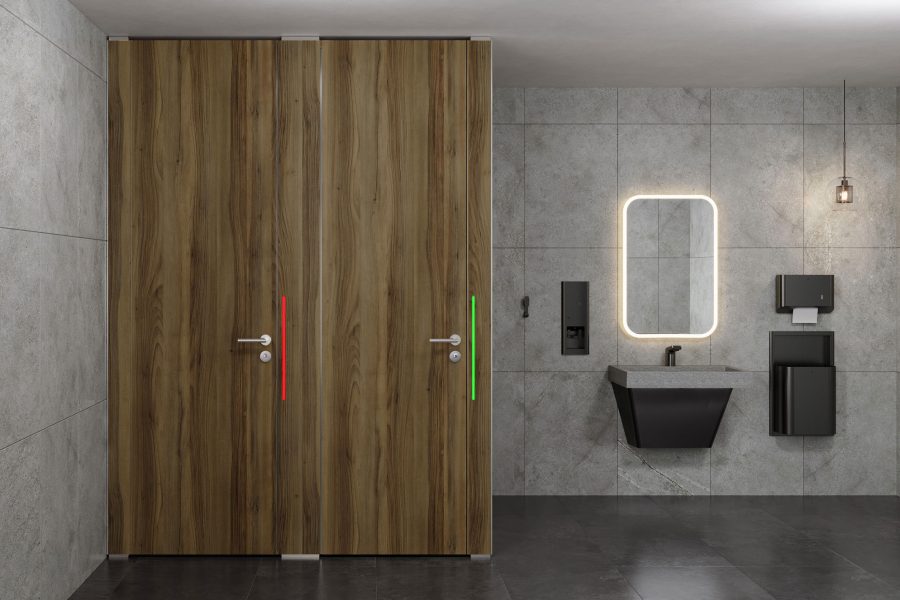
High-rise partitions in dark walnut. Photo courtesy of Bradley Company
70% of Americans want more private washrooms. And it’s not just a preference—it’s a safety issue.
“The international market has always been much more private than the US. A lot of times when you walk into a commercial restroom, you can see people through a big gap. You can see their legs. It’s not very protected,” Clark says.
Floor-to-ceiling privacy walls like Bradley’s Euro Style Partitions are becoming more common to offer a private restroom experience, ease user discomfort, and increase washroom safety.
“Some people are anxious about going to the restroom. People are much more relaxed when they feel safe, and privacy walls offer that,” she says.
2. Touchless Technology
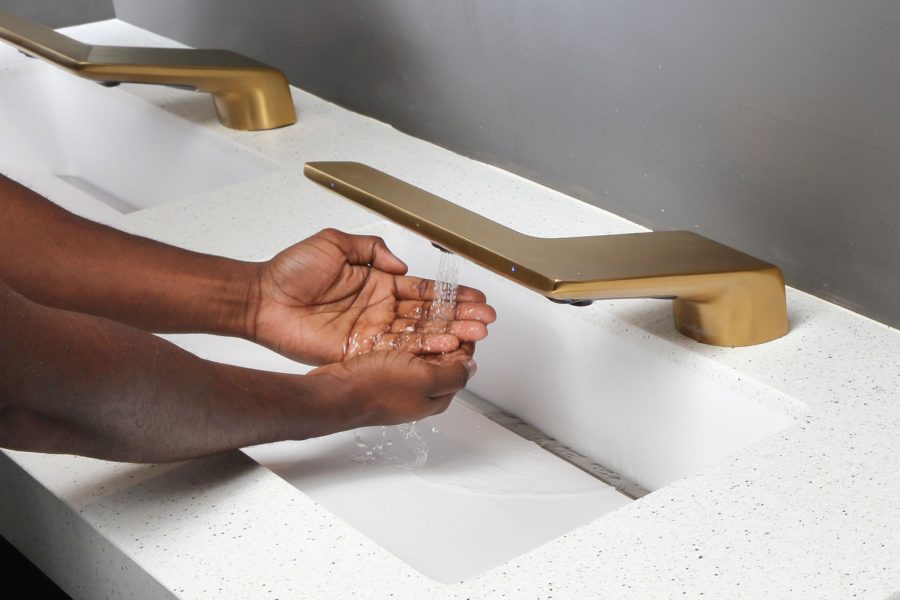
WashBar all-in-one technology from Bradley offers a completely touchless hand washing experience. Photo courtesy of Bradley Company
Coming out of the pandemic, no one wants to touch anything in the restroom, Clark says. In fact, the survey found that 86% of Americans believe it’s important for public restrooms to have touchless fixtures. But in traditional restroom design you often have to touch everything—opening and closing doors, flushing toilets, turning on and off faucets, pumping soap dispensers, hitting buttons or turning knobs on hand dryers and paper towel machines.
The push for touchless makes washrooms more hygienic, yes, but it also ushers in an era of smart bathroom technology that improves cleanliness and facility operations.
Many commercial washrooms are high-traffic areas. With an influx of patrons, people washing their hands may get water on the sink or floor while shaking their hands to dry. That water buildup can cause accidents, which puts the onus on maintenance teams to clean more frequently.
“About 75% of restroom complaints are about general untidiness,” Clark says. “The smart restroom uses technology to help reduce maintenance and keep washrooms safer from spills, slips, and falls.”
It’s one reason why Bradley was driven to create WashBar®—a touch-free water, soap, and hand dryer solution that combines all three functions into one product. WashBar keeps water to the sink basin because users don’t have to walk from sink to soap and hand drying stations. It’s all in one right in front of them—which comes with the added bonus of improved bathroom flow.
“Traffic flow and hands-free fixtures can create fewer contact points and reduce opportunities for transmission of germs,” Crosby says. “Eliminating doors where possible can also speed people’s movement in and out of the space while minimizing transfer of germs.”
3. Experience and Comfort
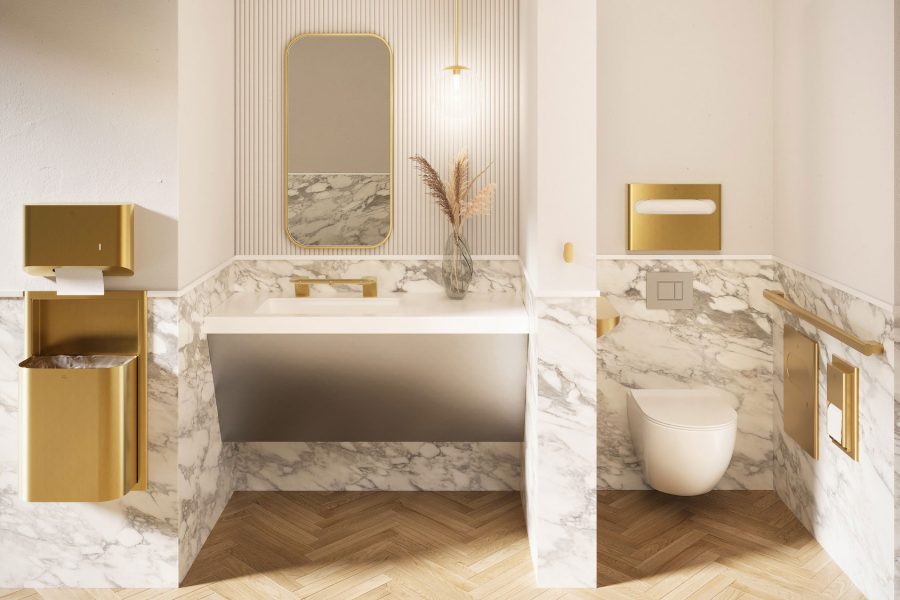
Photo courtesy of Bradley Company
However, in a major reversal of traditional bathroom design, no longer are bathrooms merely meant to serve one function and be do-your-business-and-get-out spaces. Many are designed as comfortable, even luxurious destinations in and of themselves.
“In the old days when we traveled, for example, we would go to the airport, and your vacation began when you got to your destination. The younger generation now, they start from the minute they leave their home. They want to enjoy everything from the moment they leave the house to when they arrive,” Clark says. “It’s the same for sports, for all commercial buildings. People want the whole experience. So a lot of these facilities now need to provide that enhanced user experience so they can be a whole experience.”
Crosby agrees. “Bathrooms have an ability to enhance or detract from the overall experience. Design has been democratized and there’s a higher level of expectation from everyone—a spectacular bathroom can be the cherry on top of a memorable experience,” he says.
For designers this new vision of a restroom means reimagining what a bathroom can be—both in terms of function and artistic expression—and more creative freedom. Biophilic design, lighting, color—all of these elements can create a more comfortable, modern washroom experience.
Bradley’s Elvari™ washroom accessories collection, for instance, brings minimalist, functional luxury and design cohesion to the bathroom experience across the collection’s 650 individual products—including grab bars, paper and soap dispensers, waste receptacles, LED mirrors, hooks, shelves, and more.
The point is: It’s all in the details. “Restrooms can be multipurpose and can look and feel like a modern experience when designed with intent,” Clark says. “When you go into a nice restroom, it’s a surprise. It’s uplifting rather than depressing.”

